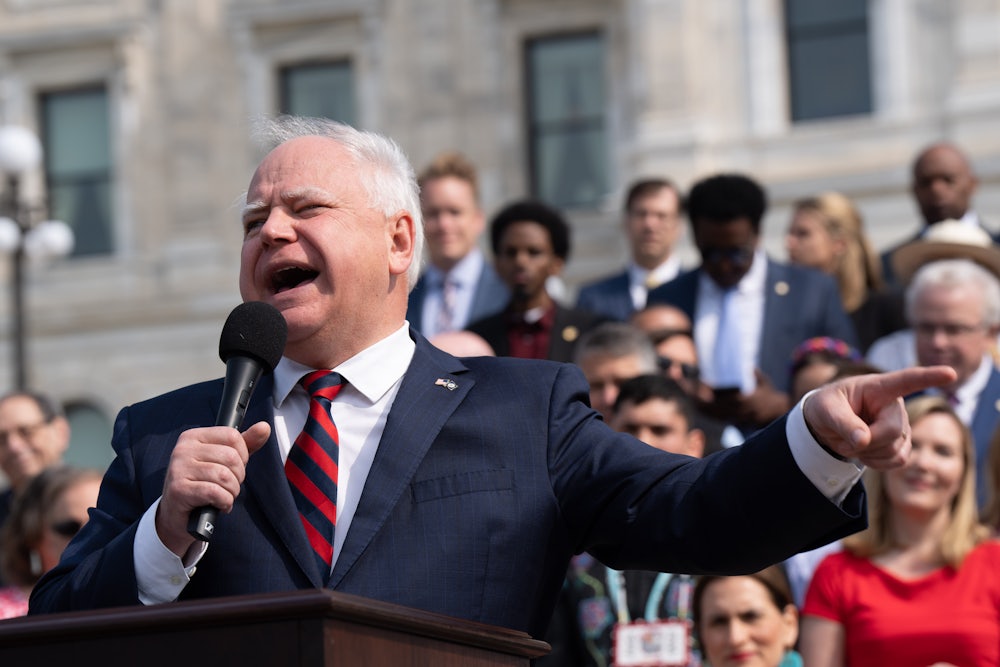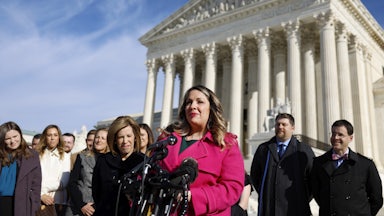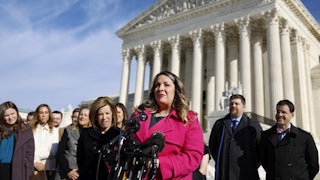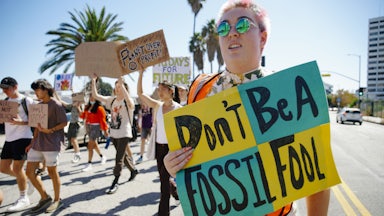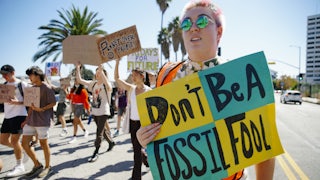In an era of divided government and partisan gridlock on the federal level, states have become the laboratories for significant social policy experiments on both ends of the ideological spectrum. While Republican-led states have recently approved a bevy of laws advancing conservative priorities, Democratic-controlled states have mirrored that pattern with progressive policies. Perhaps no state has taken more dramatic action in that direction recently than Minnesota, which saw its Democratic governor and legislative majorities work in lockstep, passing several laws to transform the state’s social and economic landscape.
“This was a bonanza year without precedent,” said Larry Jacobs, a political science professor at the University of Minnesota, highlighting the fact that the recently passed two-year budget is 40 percent larger than the current one. “Minnesota is an example of a full-on progressive gallop towards greater government activism and a willingness to spend just unimaginable amounts of money.”
Narrow Democratic majorities in the state House and Senate—including a one-vote margin in the upper chamber—made that gallop possible. Democrats unexpectedly flipped the state Senate in the 2022 midterm elections, granting the party a trifecta of power for the first time since 2013.
“It was a phenomenal legislative session.” Minnesota Governor Tim Walz told reporters during a trip to Washington, D.C., in June, adding, “I think somebody will write a book on it.” He framed the legislative accomplishments not only as “the right thing to do” but as advertisements for settling down in his state. “Northern cold states are going to have to make the pitch on why people should move and stay there,” Walz said.
For the governor and his fellow state Democrats, Minnesota’s argument is embodied in strengthened abortion protections, in paid family and medical leave policy, and in a new child tax credit for low-income parents. The list of other new policies reads like a progressive priority manifesto: restoring voting rights for the formerly incarcerated, automatic voter registration and pre-registration for teenagers, driver’s licenses for undocumented immigrants, background checks for private gun transfers and implementation of a red-flag law, a $1 billion investment in affordable housing, legalizing recreational marijuana, universal school meals, banning so-called “conversion therapy” (the practice of trying to change a person’s sexuality or gender identity), and expanding protections for transgender citizens. The legislature also passed a bill mandating a carbon-free electric grid by 2040.
Ken Martin, the chair of the Minnesota Democratic-Farmer-Labor Party—the formal name for the state’s Democratic Party—said that years of divided government imbued lawmakers with a sense of urgency. “There was a newfound zeal to recognize that power is fleeting, right? You never know when you’re going to have power again,” Martin told me. “So you should use it when you have it to make the biggest difference that you can, and that is the approach that our elected officials brought into this session.”
The ideas did not appear out of the ether; Minnesota Democrats had been preparing legislation during their time out of power. “The practical work of lawmaking is not simple or easy,” said Jacobs. Legislators must write the proposals, figure out revenue streams, and determine how money will be spent. But Democrats “had worked a lot of that out beforehand,” he continued: “When the window opened, they went charging out.”
Some advocates outside the state legislature felt that their leaders had missed that window the last time Democrats held a trifecta of power, a decade ago. Priorities such as providing driver’s licenses for people regardless of immigration status and restoring voting rights for convicted felons weren’t fulfilled, said JaNaé Bates, a Christian minister and communications director for the advocacy group Faith in Minnesota. “There was a growing frustration with people who had elected Democrats to do these good things and were realizing that those things weren’t getting done,” Bates said.
But Minnesota Democrats spent the divided-government years working with outside organizations on their agenda, so that they would be prepared for the next time they controlled all of the levers of power. Bates recalled attending a hearing on paid leave policy in the winter of 2019 during the “polar vortex,” when temperatures dropped to below minus 60 degrees with windchill. The leave bill passed that legislative session in the House, but not in the Senate, which was then controlled by Republicans. “It felt like we were losing the war but winning the small battles,” Bates said. Eventually, however, that advocacy culminated in the “ultimate win” in the most recent legislative session.
The coronavirus pandemic and the federal response to it informed other policies. The state’s child tax credit, for example, originated in the American Rescue Plan’s expansion of the federal credit, which contributed to a significant child poverty reduction during the six months that it was in effect. Although the federal policy expired at the end of 2021, several states, including Minnesota, took up their own proposals.
Nan Madden, the director of the Minnesota Budget Project, said that the federal child tax credit inspired her organization, which is focused on fairness in the tax system, to begin thinking about how such a program could be implemented on the state level. “We, like folks in other states, were like, how do we replicate that? How do we build on those lessons at the state level?” Madden said.
Minnesota’s new child tax credit provides up to $1,750 per child for couples earning up to $35,000 and single filers making up to $29,500, and then gradually phases out. There is no limit on the number of children who qualify, and the credit is refundable, meaning that it is accessible to families too poor to pay income taxes. Unlike the federally expanded credit, the Minnesota credit will not initially be disbursed on a monthly basis, but the new law allows the state Department of Revenue to devise a plan to split up the payments.
The state’s Republicans have carped about the cost of these policies. “We’re fast approaching California- and Chicago-style politics in Minnesota,” state Representative Chris Swedzinski warned. While Republicans have especially complained about the new spending, the state’s $17.5 billion surplus will offset much of it.
Republicans expressed frustration that a massive tax passage did not eliminate the state tax on Social Security income for seniors, although it did negate the levy for couples earning under $100,000 and single seniors earning under $78,000. They further decried a transportation bill that raised the gas tax and metro-area sales tax, and added a small fee to deliveries of more than $100.
Republicans also pushed back against the Democratic talking point that it was a major tax break, with Senate Minority Leader Mark Johnson arguing: “It’s disingenuous to say it was the biggest tax cut ever. It was a wealth transfer to certain groups.”
Madden said that because the budget surplus is “temporary,” lawmakers needed to ensure the policies implemented were more than a “flash in the pan” and have a stable revenue stream. For example, fully exempting Social Security benefits from the state income tax would have cost more than $1 billion per budget cycle, she said. The tax bill that implemented the child tax credit also raised around $1 billion by increasing taxes on some multinational corporations and individuals who earn more than $1 million in adjusted gross income or receive over $1 million in investment income.
And while most of the bills passed along party lines, Republican legislators supported some measures, such as a capital investments deal that increased nursing home funding.
Despite vehement Republican objections to the bills passed in recent months, Jacobs predicted that Democrats would not face a significant backlash for their legislative actions—in part because the Minnesota state Senate and the governor’s office are not up for election again until 2026. But the Republican Party has also been struggling to gain ground in what Jacobs described as a state that was “polka-dotted,” rather than simply blue or red. During its time in the trifectaless wilderness, on the other hand, the Democratic-Farmer-Labor Party has built up its base of support.
“[Republicans] are facing a powerful and potent progressive ecosystem that has candidates, and it’s got allies with money, volunteers, voter lists,” Jacobs said.
Bates argued that the past decade’s work should preclude advocates from calling the most recent legislative session a second “Minnesota Miracle,” like the story of rapid growth in the state five decades ago.
“When one thinks about a miracle, it is something that just happens.… This did not just happen,” Bates said. “This was a legislative session in which we proved that, when you decide—for yourself, for your family, for your community, for your state—to show up, amazing things come out of that. And that we have to keep showing up.”
